
If you’re looking for a comprehensive, classical history curriculum that has a more engaging style, wonderfully illustrated texts, a wide variety of fun, multisensory activities and exercises, plenty of review and that can offer strong, Christian learning, Mystery of History might be just the curriculum for you.
What We Like
But Be Careful
What Is Mystery Of History
Created by educator, author and former homeschooling mom Linda Lacour Hobar and published by Bright Ideas Press, Mystery of History is an activity-rich homeschool history curriculum with a strong Christian worldview.
Mystery of History combines illustrated readings and an assortment of activities and hands-on projects to teach its lessons, with students exploring the history of the world, from Creation to modern times, through illustrated texts, cardwork, mapwork, notebooking and more.
What Grades Or Ages Is It Intended For?
Mystery of History is designed to be a history curriculum for students in K-12.
There are four volumes to the series, with each volume corresponding to a different period of history:
- Volume 1: Creation to the Resurrection
- Volume 2: The Early Church and the Middle Ages (A.D. 30-1460)
- Volume 3: The Renaissance, Reformation, and Growth of Nations (1455-1707)
- Volume 4: Wars of Independence to Modern Times (1708-the modern era)
Unlike perhaps most other homeschool history curricula out there, there is no real hard and fast rule as to which volumes are most appropriate for a given age or grade level.
Instead, the program provides teaching guidance and activities relating to its texts that are designed to be appropriate for students of different ages and grade levels, allowing parents to scale the complexity and learning up or down depending on the students needs and abilities..
That said, although they can be used for students throughout the K-12 grade range, the Mystery of History books are written at different reading levels.
| Volume | Approximate Reading Level |
| Volume I | 4-5th Grade reading level |
| Volume II | 6-7th Grade reading level |
| Volume III | 8-9th Grade reading level |
| Volume IV | 10th-11th Grade reading level |
It is also important to note that Mystery of History’s examination of history becomes progressively complex with each volume.
For example, in Volume 4 students explore quite a few historically important, but occasionally gruesome, events that parents of younger students will need to approach with a little more caution.
While perhaps a little more unusual than some other history programs out there, such as Notgrass, which may broadly aim their programs at certain grade levels or ages, we feel that this curriculum structure actually makes a lot of sense for homeschooling families.
It allows parents of students in different grades to decide for themselves when they would like their children to start learning about history, making use of the same volumes of Mystery of History but giving them the tools to do so at a more developmentally and age-appropriate level.
As a result, much like programs such as History Quest, Mystery of History is perhaps more easily used by homeschools following a social studies program outside the typical grade range.
For example,homeschooling families of precocious younger students can make full use of the series to satisfy their students’ love of learning, with parents reading texts aloud, engaging in more hands-on learning, and even carefully shifting around some of the more gruesome details of certain time periods.
What’s Required To Teach The Curriculum?
For the most part, Mystery of History is a pretty straightforward history curriculum, with the core material for a year’s work largely spread between a history reader and a companion guide.
In addition, there are some supplementary items, offered separately, that go with each volume of the series and that tend to help with teaching or add to the overall learning experience in some way.
Mystery of History Readers
Each reader in the Mystery of History series contains all the history learning for that period of time.
The books themselves are hardcover and non-consumable, acting something like textbooks for the course.
They are quite well made, being full-color, beautifully laid out and illustrated, with gorgeous maps, illustrations, paintings, photos and more spread throughout their pages, so they are pretty engaging for students to look at and use as they study.
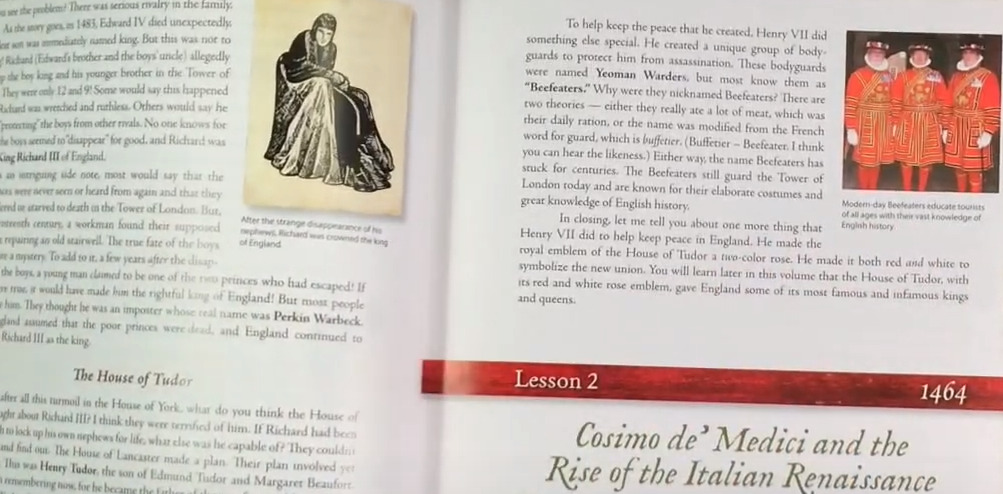
This is actually something of an improvement, in our opinion at least, from previous editions of the series, which were softcover books printed in black and white that we didn’t feel really gave students as engaging an experience or conveyed the true beauty of some of the historical artwork included with the text.
The readers are available in a variety of formats, including print form, PDF and, interestingly enough, in audiobook format (CD and downloadable MP3).
The audiobook versions make the program very accessible for older students who have trouble reading, as well as busy homeschooling parents of younger students who may not have the time to read entire chapters aloud.
On the downside, at 400-700 pages long (depending on the volume) Mystery of History readers can be somewhat intimidating for some parents and students. Further, usually coming in at over $50, can be something of an investment for some families.
Helpfully, though, some editions of the series are also available broken up into quarters, which can save families in terms of upfront cost and can be a little less intimidating to use.
Interestingly, when purchased as a full textbook, Mystery of History readers also come with a code that can be used to download a free PDF version of the companion guide, which can represent a bit of a savings for budget-minded families who don’t mind printing things out or reading from a screen.
Companion Guide
Accompanying each volume of the history readers is a companion guide, which contain pretty much everything parents and students need to have a complete year’s instruction in history, including lesson plans, tests, reviews, activities and games, timeline instructions, map work, extra readings and more.
As mentioned above, digital versions of the companion guides are available for download with the purchase of the readers, although families who want to limit screen time or avoid printing and bind several hundred pages worth of text will probably want to pick up a print version.
Print versions of the companion guides are softcover, printed in black and white and, like the readers, are fairly substantial, having between 500-600 pages depending on the level.
They come as 3-hole punched loose-leaf paper packets, and are ready for being put into a 1.5-2-inch binder, which can be a plus or minus depending on the relative craft-iness of a parent and how much they appreciate sorting and organizing their homeschool materials.
Supplements
Finally, Mystery of History and its publisher, Bright Ideas Press, offer a variety of supplements to go with the program and are sold separately.
There are quite a few options to choose from. There are, for example:
Challenge cards – these are sort of history-oriented game or flash cards designed to be used to help students remember the most important facts for each volume of the program.
Typically, questions are printed on one side and the relevant answers, including any important context, are printed on the other.
While the companion guides offer instructions for creating homemade flashcards, these can act as as-needed supplements or as a replacement, depending on parent preference.
Coloring pages – these are black and white coloring book-style pages designed to accompany history lessons and can add a bit of educational fun and relaxation to a student’s studies.
Notebooking pages – For homeschools that are fans of notebooking or journaling, Mystery of History offers ready notebooking pages that can allow students to record their thoughts, key takeaways, opinions, original research and more.
Interestingly, these notebooking pages are offered in a few different formats to suit different homeschool needs- a blank format for personal journaling or handwritten work, a partially filled-out PDF that can be typed into, and custom pages for older students doing research and written exercises (Clever Information Pages)
Folderbooks – Younger students and homeschools that prefer lapbooking can choose to use these folderbooks instead, letting students handle, organize, cut out, color and keep things they’ve learned throughout the year.
Timeline figures – Mystery of History has a good deal of timeline work involved in it and to help students and keep things a little more visual and hands-on, the company offers a variety (a hundred or more per course) of cartoon-like timeline figures that can be cut out, colored and assembled in a timeline book.

A joint project with Home School in the Woods, these are available as pre-printed cardstock pages, but unfortunately tend to sell out quickly.
While there are quite a few supplements available for Mystery of History, they are optional and parents can pick and choose which to buy if any) depending on their philosophy.
We like this flexibility and much prefer it to programs that require a variety of resources, as it allows parents to strip down or expand the curriculum as they prefer or as budget allows.
One thing to note about Mystery of History supplements is that, for the most part, they are available as downloadable PDFs, rather than ready printed products.
While some parents don’t really mind printing and setting things for their students, others may not really appreciate the extra prep time involved.
Another thing to be aware of is that, while lessons often involve a good deal of geography and map work exercises, the companion guide and readers do not include a good deal of included information in this regard.
Instead, in order to complete the map work assignments Mystery of History does more or less require parents to get their hands on a supplemental atlas, such as the Rand McNally Historical Atlas of the World, The Student Bible Atlas or Wondermaps, which can increase the cost of the program somewhat.
Mystery Of History Approach To Teaching
History with a strong Christian worldview
Mystery of History approaches history with a very strong Christian worldview, something we will discuss in more depth a little later.
It is a Young Earth history curriculum, meaning that its examination of early history begins roughly around 4004 BC, aligning with the Ussher chronology, and its subsequent study of ancient history (Volume 1) weaves biblical events into its chronology.
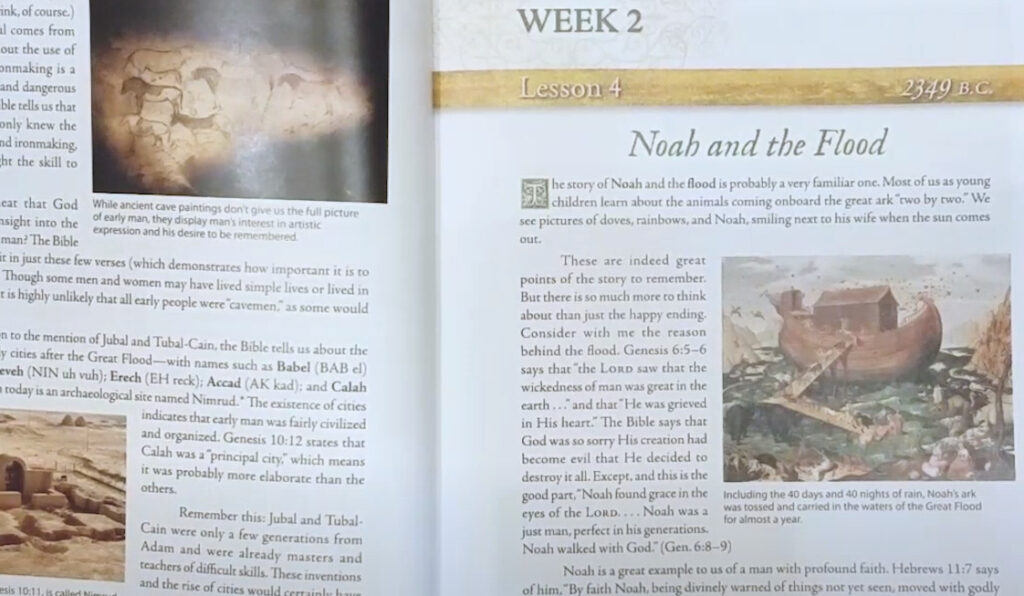
While it explores history in a good amount of depth, Mystery of History can, at times, explore historical events through a lens of divine providence and biblical revelation.
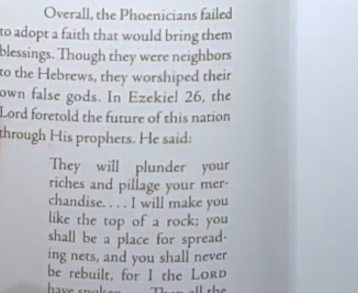
Overall, as a curriculum, Mystery of History effectively combines faith, history and Christian values into its curriculum far more than many other faith-friendly history curricula we’ve seen.
As a consequence, the program can be a great and effective option for families who want to combine history and bible study, although perhaps it is not the best option for those who wish to keep these subjects separate or who don’t hold to Young Earth creationism.
Activity-based learning
Mystery of History is an activity-rich history curriculum.
Rather than relying on typical reading and writing tasks, students take a more active hand in exploring history through a variety of exercises, tasks and projects.
At any given time, and depending on their age or grade level, students can deepen and often personalize their understanding of what they’ve learned by listening to relevant music, singing hymns, drawing, sculpting, baking, building, researching, writing and much, much more.
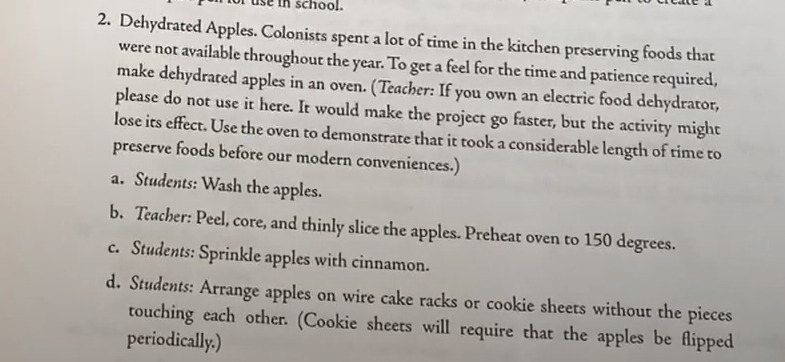
These activities are not only educational, directly relating to the history topic at hand, but they are often highly engaging for the student (and often lots of fun), frequently getting them personally involved in their own learning and making the learning more meaningful and memorable.
Further, these activities make learning with Mystery of History a far more multisensory learning experience, making it a more useful and engaging curriculum for students with different learning preferences, such as tactile, kinesthetic and auditory learners.
Scalable and flexible learning
As we mentioned earlier, Mystery of History’s book series is intended to serve a K-12 audience, letting students of all ages satisfy their curiosity and thirst for learning history but is also designed in a way that allows parents to scale the complexity of learning up or down to better fit with a student’s age, readiness and needs.
To help do so, each volume in Mystery of History contains activity ideas aimed at students in different grades.
While the text remains constant (parents of course, being encouraged to read it aloud to younger students), each accompanying lesson gives parents a choice between activities and exercises aimed at what it refers to as Younger, Middle and Older students.

Younger Students, about grades K-3, are provided with a variety of more one-one one engaging hands-on exercises, arts and crafts projects, as well as different sensory-based activities.
A lesson on the creation of life on earth, for example, might have the students make their own imaginary animal out of playdoh.
Middle Students, approximately grades 4-8, on the other hand are challenged to integrate and find creative uses for the information they are learning, occasionally doing light research and reporting.
In the same lesson on the creation of life, they may be asked to do a self portrait, noting how they were created in God’s image and being asked to detail or place the drawing geographically by where they live.
Finally, Older Students, around 9th to 12th grade, are given more complex and independent assignments, and are generally expected to engage more in research, analysis and discussion of the topics they read about.
For example, in this same lesson on creation, they may be asked to read a particular novel and discuss the author’s approach to history, the bible and where they feel the information is correct and where it may be embellished.
The overall idea is to help these students explore and engage with history and the bible, allowing students of all ages to explore history while giving them activities and exercises that are challenging but developmentally appropriate and less likely to frustrate.
While perhaps not extremely specific, by using broader terms such as Younger, Middle and Older rather than an age or grade range, Mystery of History provides parents with more flexibility to adapt to a particular student’s needs and abilities.
There is nothing, for example, really stopping a precocious 3rd grader from tackling more challenging activities (Middle Student activities, for example) if they get bored with those aimed at Younger students.
Narrative, storytelling style
Finally, and much like Notgrass History or The Story of the World, rather than relying on a dry and to the point listing of facts and dates, Mystery of History readers use a narrative approach.
This is to say the books are written like a fact-filled story filled with interesting historical characters and exciting events rather than a dry recitation of facts and dates.
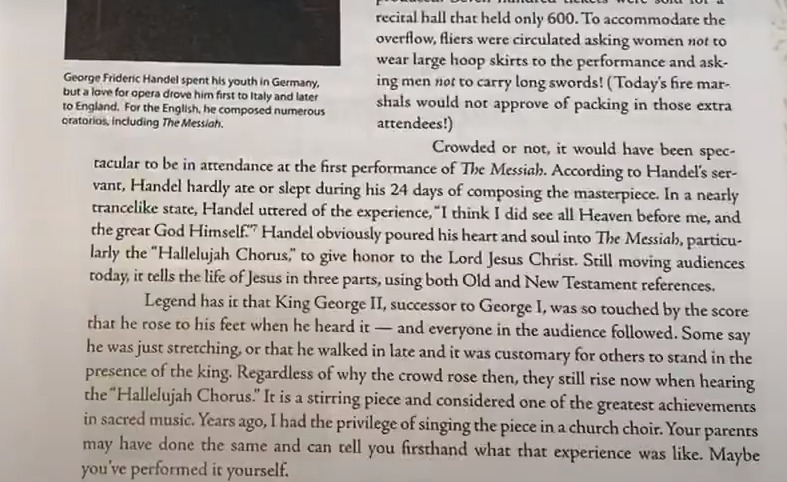
This storytelling style can make learning history a lot more entertaining for students (and parents if they are reading them aloud), making history more relatable and relevant for students and adding a good deal of richness to its study that should help kids sit up and pay attention a little more.
That said, even if the tone and writing style is a little more casual and approachable than a standard textbook, Mystery of History’s examination of history is still quite rigorous, with the books being filled with facts and providing students with a thorough analysis of events.
Lots of Review
With a seemingly endless parade of facts, figures and dates, studying history can sometimes be a little challenging for students.
While some students can seem to soak up these facts like a sponge, others may need a lot more revision and review to remember key events and details.
To help these students out, Mystery of History has built quite a few opportunities for review into every volume.
In addition to dedicated review exercises, flashcard work and assessments in the lessons, there are biweekly quizzes, quarterly review exercises and even cumulative midterms and finals.
All of this is intended to provide students with ample opportunity to both review, practice and be assessed on their knowledge of history, which can help keep learning fresh and strengthen a student’s memory of facts and dates.
How It Works
Every volume in Mystery of History is its own curriculum, with its own course instructions, learning materials and activities.
Each volume in Mystery of History contains 84-108 lessons that, at the recommended pace of 3 lessons a week, makes for about a full year’s worth of history study (28-36 weeks).
Each week begins with a brief and casual pretest (called “What Do You Know”), which is generally a series of brain-teasing riddles designed to gauge what students might already know, as well as sparking their curiosity or interest in topics they aren’t familiar with.
The week’s lessons themselves follow a common structure across the different volumes of the series.
Information is first presented and explored in the reader, with either parents reading a section aloud or the student doing so on their own (depending on age and ability to read).
Generally speaking, each reading is about 1.5-3 pages long and so isn’t too much fo a challenge for either students or parents reading aloud.
The curriculum also includes a rather sizable section in the appendix with additional readings for students, which includes a topical and lesson by lesson list of various resources they can explore to deepen their learning.
There are, for example, various books, readings, films, audiobooks, and references to the various supplementary materials that parents can purchase and use such as fact cards, coloring books, notebooking pages and more.
Following this, parents and students move on to the lesson’s activities.
As mentioned previously there are three options to choose from, based on the student’s ability and readiness (Younger, Middle or Older).
Depending on the option, a student might engage in hands-on arts and crafts or pursue deeper research into a topic, reading and critically analyzing the topic in more depth using additional sources.
By the third lesson, presumably at the end of the week, students engage in a general review and do some geography work.
Typically, at this point students create Memory Cards, sort of like fact-filled flash cards that cover the main idea of each lesson and will be used for later review, drill and practice games.
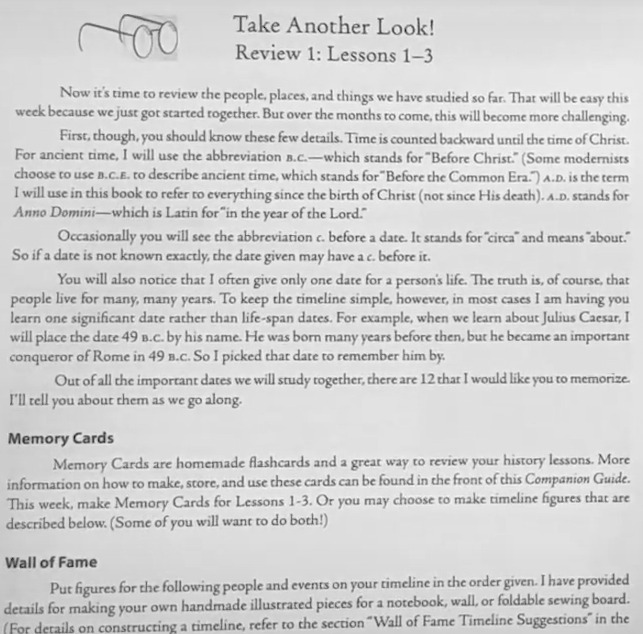
Students are also encouraged to do mapwork, filling out blank maps with geographic and historical information.
As mentioned previously, neither the readers nor the companion guides contain the pertinent geographic information necessary to properly fill out the maps, so parents and students will unfortunately have to get their hands on an atlas to properly complete the work.
In addition to the mapwork, students also have the opportunity to work on timelines, pursue a variety of hands-on activities and exercises and play various history related games.
In addition to these activities and exercises, every other week students have two particular activities, entitled “What Did You Miss” and “What Did You Learn.”
“What Did You Miss” is something of a review exercise, offering various games and activities that encourage students to review what they’ve learned and often gets older students to combine and integrate the information they’ve learned during their lessons so far.
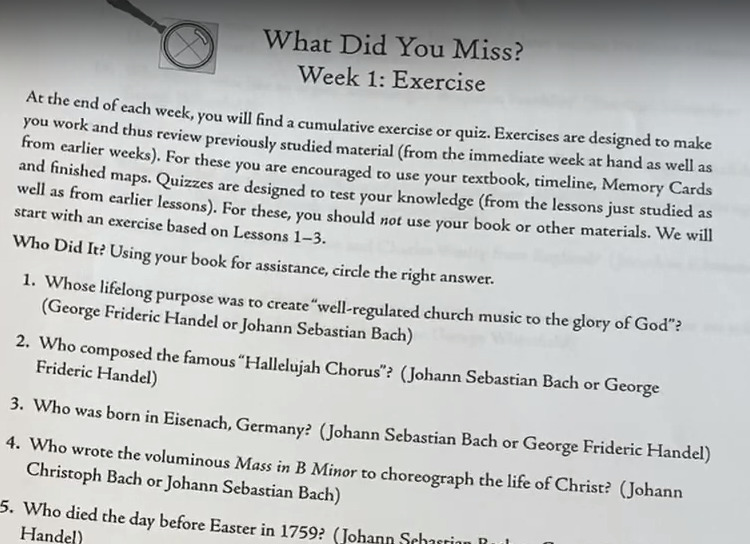
“What Did You Learn,” in contrast, is more like a general, cumulative quiz that draws on previously learned material in order to make sure students are paying attention and retaining the material so far.
Every quarter, that is every 7-9 weeks, there are quarterly worksheets that students can work on. These are open book assessments that help students review all the material they’ve learned so far and find any gaps in their knowledge that may exist.
Finally, the program also offers cumulative midterms and final exams that parents can choose to administer, should they so choose.
Our Thoughts on Mystery of History Lessons
Overall, we believe that Mystery of History offers homeschooling families a fairly deep and activity-rich way of exploring history.
The history readers themselves are beautifully illustrated and are very interesting to read.
Although at times their reading level may be a little ahead of where an individual student might be, their storytelling style makes them more accessible and a lot easier for even younger students to understand, especially if a parent is close by to help explain things.
The curriculum is activity-rich, making the study of history a lot more hands-on and engaging for students (and parents) compared to many others, and a lot more effective for tactile and kinesthetic learners, which we appreciate.
And, more than that, many of the activities are actually enjoyable for both parents and students.
Whether it’s building something, enjoying music or even baking or cooking historical snacks, students can have a lot of fun in Mystery of History lessons, which in turn can help with their long-term retention of facts and their enjoyment of history as a subject.
Further, because the program offers different activity types for different ages and grades, parents can really tailor the program to their students needs and abilities, allowing students of all ages (with perhaps a little curation from parents) to study a much broader and complete range of history topics than is typically offered.
For example, where other programs may only offer early elementary school students a course in ancient history, with Mystery of History students through K-12 are encouraged to study all eras of history, from ancient history through to the modern era.
Finally, we appreciate that Mystery of History offers a lot of review options.
With optional review activities, exercises and assessments at the weekly, bi-weekly, quarterly and semester levels, parents can really tailor the program to make sure that students retain the information they are learning.
And, because these review options are not simply tests and quizzes but also include activities, games, and open-book exercises, they are not necessarily always so stressful.
On the downside, while there are many different ways to help younger students engage with the curriculum, we believe the readers can still be lesson-like and a little dry/fact-intensive for very young students, such as those in grades 1-3.
Consequently, while the learning activities can certainly be very engaging and informative for such young students, parents may need to summarize the main points from time to time.
Another thing that parents may be an issue for some parents is the fact that, as more of a classical history curriculum, Mystery of History does not include a dedicated American history component, instead weaving American history into the material as part of a larger picture.
While not particularly an issue for those interested in a more classical approach to history or homeschooling, those that want to include a dedicated American history component may need to look elsewhere.
Finally, while Mystery of History can be very attractive because of the flexibility it offers parents as a curriculum, this can have its downsides as well.
While we feel that more experienced parents will certainly appreciate the different activities, exercises, review components and supplements available for the program, as well as the ability to scale the learning to meet different student ages and abilities, those new to homeschooling may deciding what to include and how much to be a little much at times.
While the books do offer a good deal of advice for parents in their introductions, parents still need to assess their own needs, budget and student ability, which can require a bit more pre-planning for those not used to doing so.
How Easy Is Mystery Of History To Teach?
Overall, we believe that Mystery of History is pretty easy to teach and learn from.
The books themselves are written in a fairly compelling way, and the companion guides generally provide a good deal of detail and step-by-step instructions, helping parents know what to teach, what to emphasize, how to set up and run activities and what to do next.
As a result, the program is fairly open and go, guiding parents sequentially through history reading, lessons and activities and so we don’t feel it should be too hard to use for homeschooling parents, regardless of whether they have a good deal of experience in teaching or are new to the whole endeavor.
Being a hands-on curriculum, however, it does mean that there can be a bit of prep-work involved when setting up and running activities. While the activity plans provide all the information concerning the materials required and steps involved, it is ultimately up to the parent to get supplies, organize things and set everything up correctly.
Is Mystery Of History A Christian Curriculum?
Mystery of History is a very strong Christian history curriculum.
Unlike some other bible-based curricula out there, it does not just pepper scripture and bible quotes here and there.
Instead, the curriculum frequently views historical events through the lens of divine guidance and Christian values, often balancing historical facts with references to God, morality and faith.
For rather obvious reasons, this is particularly seen in the first volume of the series, Creation to the Resurrection, which tends to take a Young Earth creationist view of history, but later volumes still make references to God, the Bible, Christianity and Providence.
Further, there are a lot of faith-centered activities to go with the readings, such as various Bible study exercises.
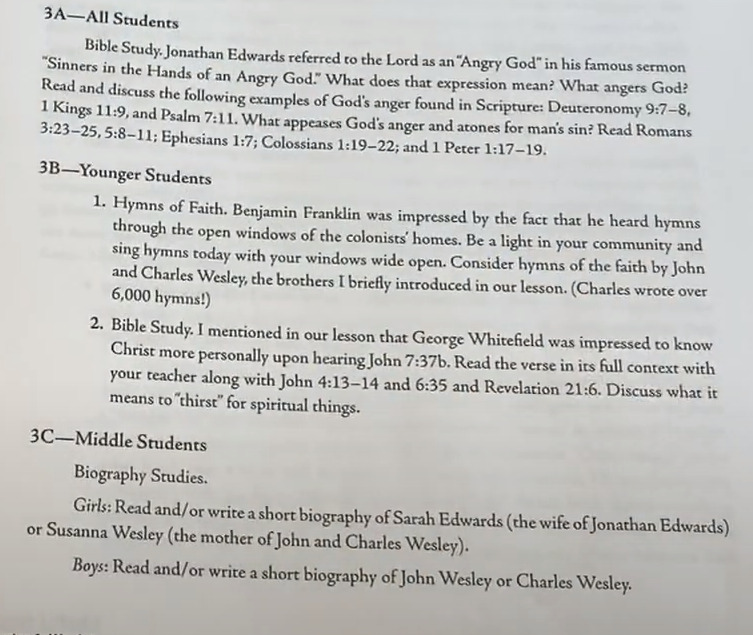
That said, while it does have a very strong faith-based component, parents should not ethat Mystery of History still provides a strong, in-depth study of history.
The program does not really shy away from any topics in history and dives deeply into the material, giving students an excellent understanding of key figures and providing them with a detailed, big-picture view of historical events, ultimately providing as much fact as faith in our opinion.
Further, although the curriculum does focus more heavily on Western civilization, the program does touch on different historical civilizations, people and cultures, as well, with lessons on the Aztecs, Great Zimbabwe, Japan, China and more.
Overall, then, we feel that Mystery of History can be a great curriculum for those looking to balance a rigorous social studies/history program with a deeper Christian homeschool philosophy.
While it is true that the curriculum does tend to favor a more strict, Ussher chronology of Creation, which is something that some Christian homeschooling families may not necessarily hold to or agree with, this is really only an issue for the first few lessons of the first volume, beyond which the volume (and then the rest of the series) follows a more typical historical chronology.
Pros And Cons Of Mystery Of History
Pros
Engaging approach to history
Mystery of History recounts history through a more casual narrative approach that tries to bring history and historical figures to life and make history more interesting for students.
Although perhaps not as fun to read for younger students as a fictional retelling, such as favored by programs such as Story of the World, on the whole Mystery of History manages to balance its engaging approach with a strong and in-depth look at history and can be a lot more interesting than a dry, textbook-style recitation of facts and dates.
Lots of fun, multisensory activities included in each course
Whether its coloring, drawing, building, analyzing and researching, playing music, playing games, singing hymns or even baking and cooking, Mystery of History offers students and parents a lot of activities to help make learning more fun and multisensory, allowing it to more effectively fit a wide variety of learning styles.
Strong Christian worldview
Rather than tack on the occasional bit of scripture, Christian faith, study and the Bible are more deeply woven into Mystery of History’s study of history than many other curricula out there, providing homeschool families with a strong, Christian look at history, as well as a plethora of interesting Bible-integrative and faith-based activities and exercises to try out.
Flexible and configurable
Mystery of History offers a great deal of tips, advice and a choice of age/grade-adjusted activity ideas and exercises that allow students of all ages to enjoy its examination of history.
Further, there are many options to supplement the program with different learning materials, and a wide variety of suggested readings and resources that can further enhance reading, should parents so choose.
Consequently, parents are free to scale the learning up or down as needed or as fits their homeschool philosophy and budget.
Thorough history study
Although presented in a somewhat easier to read, more casual manner, Mystery of History still provides a thorough examination of history in our opinion.
The curriculum offers a pretty fact-filled study of key places, events and critical figures of history, never really shying away from difficult concepts or events, and the accompanying lessons allow students to dive deeper into what they’re learning, letting them take their time to think about and/or analyze events in more detail and in a more meaningful way.
Lots of review and practice for those who need it
With ample dedicated review built into the curriculum, through various quizzes, games, drill, revision exercises, midterms and finals, Mystery of History provides parents with a lot of opportunity to help students practice and ultimately absorb important history facts and dates.
Cons
Some supplies need to be purchased separately
While it can be used with just the reader and companion guide alone, there are a variety of interesting and effective learning supplements that parents can purchase to really make the most out of Mystery of History, including flash cards, notebooking pages, folderbooks, timeline figures, additional readings, atlases and more, which much be purchased separately.
Up to parents to decide what/how much to include
While the author offers a lot of help with all the supplements, activities, assessments and reviews included in the program, ultimately parents will have to decide what materials to include and what is best for their student, which can be a little challenging for those new to homeschooling.
Language can be a little advanced for younger students
Although the program does its best to recount history with an engaging, storytelling style, ultimately Mystery of History is a fact-rich and thorough history curriculum, and (especially in later volumes) it can be a little difficult for younger students to understand and sit through at times.
Parents therefore may need to summarize and explain some parts of the series, as well as remove some of the more gory details and events of history.
Who Is Mystery Of History Ideal For?
Those looking for a strong Christian history curriculum that is also fairly rigorous
Mystery of History is a very strong, faith-based history curriculum that dives fairly deeply and thoroughly into its subject matter, providing students with a fact-filled examination of history that also strongly integrates faith, morality and Bible study through its readings and related activities.
Those looking for an open and go curriculum
Mystery of History does a great job at carrying parents and students through lessons without too much confusion or difficulty.
As a result, those who aren’t all that comfortable teaching history, don’t have time to really prepare lessons or who are new to homeschooling should have no trouble picking up and using the curriculum pretty much right away.
Those looking for an activity rich, hands-on approach to history
Parents and students who enjoy learning through fun, multisensory activities will have a lot of opportunities to do so with Mystery of History, where each lesson includes activities that can have them exploring history by drawing, singing, feeling, touching, building and more.
Students who need a good deal of review
Some students have an easy time with facts and dates, while others need more opportunity to review in order to absorb them properly.
Offering built-in quizzes, reviews, drill, games and periodic comprehensive assessments, Mystery of History can be a great option for students who benefit from more practice.
Younger students who have a strong interest in history
Because it offers a selection of age-appropriate activities, tips and lesson guides throughout its series, Mystery of History lets students of all ages embark on an interesting and comprehensive study of history from Creation to modern times.
Dyslexic students, those with learning difficulties and those who learn best through audio
Mystery of History offers its readers in audiobook format, which combined with its wider variety of hands-on activities and visual exercises, can make it a good option for those with reading challenges and those who learn better by listening.
Who Is It Not Ideal For?
Those who prefer a serious, textbook like approach to history
Some students and parents appreciate learning through games and activities. Others, however, prefer a more direct textbook approach and may become frustrated by Mystery of History’s narrative approach, finding it a bit too casual or folksy at times and may become frustrated by all the games and hands-on activities.
Those looking for a secular or neutral homeschool curriculum
Mystery of History is a strongly Christian curriculum that often views history through the lens of faith.
As a result, it may not be a good fit for those looking for a secular or even neutral history curriculum.
Price
Note: Prices correct as of writing. All prices in USD.
As mentioned previously, the core of Mystery of History is its reader and companion guides, but there are a variety of supplements available as well that can enhance learning.
Generally speaking, however, Mystery of History readers cost about $74.95. These come with codes that allow parents to download free PDF versions of the companion guides.
Print versions of the companion guides cost approximately $39.95, should parents prefer a hardcopy that they don’t have to print on their own.
Supplements for each volume are digital, available as PDFs and can be purchased as a bundle for about $59.95.
Otherwise, they can be purchased individually. Some approximate prices can be found below.
Challenge Cards – $14.95
Notebooking pages – $19.95
Coloring pages – $14.95
Cookbook – $8.00
Mystery of History can be found through different retailers, and can be offered on sale or at a discount, and so it is important that homeschooling parents check for the latest prices.
Or
Or
Is It Worth The Price
Although not the cheapest history curriculum around, Mystery of History can provide a great deal of value for Christian homeschools.
Its readers are well-designed and well-written, using an engaging narrative style as well as full color, beautiful illustrations and photos that can make reading them a lot more interesting and engaging for students.
Further, the lessons included in the companion guide are well-organized and clearly laid out, providing enough detail to guide parents and students through lessons quickly and effectively, meaning there isn’t a ton of prep-time required to teach.
Mystery of History also includes a lot of fun and interesting multisensory activities and exercises that can suit a wide range of learning style.
The program also offers different age-adjusted activity options for each lesson, letting parents better fit the program around their students’ development, ability and needs and allowing students of all ages to enjoy a comprehensive study of history.
Finally, Mystery of History weaves Bible study, Christian thought and faith pretty tightly and comprehensively into its lessons, helping create a more integrated, deeper and richer Christian learning experience than many other faith-based curricula we’ve seen.
Bottom Line
If you’re looking for a comprehensive, classical history curriculum that has a more engaging style, wonderfully illustrated texts, a wide variety of fun, multisensory activities and exercises, plenty of review and that can offer strong, Christian learning, Mystery of History might be just the curriculum for you.

Jennifer Keenes is a writer and a new mom living in Florida. She studied education and, prior to becoming a freelance writer, worked as a substitute teacher at the elementary and middle school level. She is a big fan of the beach, working out and homeschooling her two daughters.
